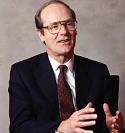Jeff Hunter & Jo Bowman
First published in Research World September 2010
How does business connect the dots?
Some of the best business ideas and the biggest threats to success seem to come out of nowhere. Consultant, author and Professor of Marketing George Day says you can see them coming – you just have to know where to look and how to connect them to your company.
Usually in business, the ability to focus is a quality to be admired. But the ability to soften that focus is what makes some of the most dynamic and successful companies so good at spotting new opportunities and running with them. George Day is Professor of Marketing at The Wharton School, University of Pennsylvania. He says peripheral vision is one of the hallmarks of many outstanding companies, and one that can be learnt and honed by those that don’t yet have it.
When he talks about peripheral vision, Day means not crystal-ball gazing but rather developing an ability to see what’s coming, before it gets so close that you’re underneath it – whether that’s an impending economic crisis or a consumer trend that’s quietly bubbling away. “This drives profitability and helps to avoid being blindsided or surprised by competitor moves.It also positions you to capture opportunities sooner.”
Looking at the “fuzzy zone” that extends beyond the core operations of a business is where it’s possible to detect weak but identifiable signals of what’s to come. The difficulty is that among these signals is a lot of other noise that doesn’t necessarily lead anywhere. Only about 20% of companies have the capability to track the complex periphery and act on what they see, Day says. Among them are names like Amex, Johnson & Johnson, Henkel and Anheuser Busch, all of whom effectively keep track of multiple markets, competition, multiple stakeholders, collaborators, regulators, the press and emerging consumer trends. What sets them apart is their ability to track these things in a systemised way, collate what is found, and develop strategic options from what they unearthed.
It’s critical, Day says, that companies let everyone involved know where they should send market intelligence, and that they’re encouraged to do so – a kind of wisdom of crowds for the workplace. “Quite often what you find, in every case where a company was blindsided or missed an opportunity, was that there were a number of people within the organisation who knew all about it,” he says. “The problem was they didn’t know that top management needed to know, and senior management didn’t know that they knew.”
The view from outside
Seeing something coming is not enough to create a business advantage, Day says. “The financial crisis is a perfect example … some companies profited enormously from the mortgage meltdown and the question is: how did they see it sooner, and what did they do about it? Well, in most cases, they built what we call strategic options, they protected themselves, and they hedged.”
Anheuser Busch’s success with low-carbohydrate beer, launched long before any of its competitors did the same thing, is a shining example of reading early signals on the periphery, and acting upon them. Day says the company noted growing consumer interest in low-carb diets seven years before its product actually went to market. As it became clear that this was an enduring, widespread trend, the company started product development trials on a low-carb beer, and gradually progressed to getting manufacturing capability in place, and some early marketing testing. It meant that when a decision was made to go ahead with the product, it could be made, marketed and launched within a month.
“The success of Anheuser Busch was borne of seeing early and acting very, very carefully. They bought options by looking at what it would take to build a successful product and marketing campaign and they had all the pieces in place, ready to go when the time came … I think you could apply that to almost any market.”
At IBM, they develop what they call “crows’ nests”, where people or teams monitor whole areas of technology on a systematic basis. Other companies focus on answering pertinent questions, such as, in the case of a medical products company, ‘which chemical technologies or drug technologies could put us out of business?’ We’d consider that to be a really good question that focuses the organisation on certain parts of the periphery. Then these companies use triangulation to figure out what these ambiguous signals really mean.”
The management style of a company has a huge impact on its ability to view and act on peripheral vision, Day says. Those that take what he calls an “inside-out” view of themselves might be efficient and mine their current markets well, but are not good at peripheral vision. It’s the “outside-in” companies that are really responsive. “They take the point of view of their consumers and their competitors and understand the possibilities. And then in order to act on these outside in insights they focus their resources on the guiding questions where major threats and opportunities are likely to emerge, then they assign accountability. If leadership makes this a priority, the organisation makes it a priority.
“We really see a huge difference between companies like Amazon that start with their customers’ needs, problems, competitors and so on, and then they look at their strategy, as opposed to ‘here’s what we can do, how can we apply it or improve market share of efficiency’. It’s an amazingly different mindset.
Coming soon
From Day’s perspective on market research, which comes primarily from the client side, he sees developments on the periphery of the business with big implications. “They won’t be big surprises, but you take them all together ad they represent both huge challenges and opportunities.” The kind of market studies that used to be researchers’ bread and butter are now readily available on Google; anyone, anywhere can conduct an online survey, and the volume of data coming in to businesses is growing by roughly 50% a year, he says. “I find most of the companies I work with are pretty much overwhelmed with the data they have, which is not information, and processing it, making sense of it and acting on it. That’s, I think, a huge area for marketing researchers to get their arms around – helping clients interpret and act on all this data that’s coming at them.”
Day is fascinated by the willingness of young people to post personal information about themselves online. There’s a generational divide at play here, he says, and one that might not last, as people realise the implications down the line of having made their personal history readily available. The implications of this online openness for business are clearly exciting, but compound the problem of data overload that many are facing.
“It’s a rich, complex, fast-changing environment and it really complicates the periphery, but we have to figure out how to tap into it, and that’s where mindful questioning becomes important … the best companies are tracking it and making sure that whenever they’re mentioned they’re aware of that and they see what the sentiment is. It’s exciting, it’s somewhat overwhelming, but it’s going to be where the marketing research industry can certainly help with tracking and coming up with early-warning systems so that if you have complaints about a product you can act on them quickly. That’s part of the secret.”
Data blindness can come from having simply too much of the stuff, but also from having too uniform an approach to looking at it. “We tend to see what we expect to see rather than what’s there … and go in with a fixed mental model,” Day says. This points to a need for diversity within a business –rather than hiring, as tends to happen, like-minded people to join a fairly homogenous team who have the same instinctive DNA. Teams need to combine the culturally and ideologically diverse. “We want to tap into our mavericks, someone who’s fairly regularly at odds with management.”
Fish and fowl
Market researchers must also deal with a fast-changing competitive and uncertain business structure on the client side. Day says that as well as becoming more informed and more demanding in their approach to buying research, client-side marketers are dealing with uncertain budgets and uncertainty about the structure of their companies. An American Marketing Association study on the future of marketing recently signalled a likely shift towards “open architecture” in business rather than a top-down hierarchy, meaning that research partners will need a deeper insight into clients’ overall strategy rather than just a small part of it. Researchers need to get closer to the locus of decision making.
“One of the longer-term trends is that much of the value created by the market research industry is actually captured by consulting firms, who are often major employers of market research firms,” Day say. “Management consulting is a US $300 billion industry. They spend a lot on marketing research, and clients are increasingly relying on them to help them make sense of this complex periphery.” This is fertile ground for the growth of some of the bigger market research firms, he says. “And, as in many markets, there will be room for the highly specialised companies that can find a niche and really add value to it. I do wonder about the mid-range firms that are neither fish nor fowl, but that’s a question that will probably unfold in the next few years.”
Market researchers must set their sights beyond a single project and what they can give the client from it, and focus more broadly on the bigger implications of their findings and the questions they could help answer. “Winning companies that have great peripheral vision tend to look at the world from the outside in, and that guidance applies to the market research industry every bit as much.”
 George Day is the Geoffrey T. Boisi Professor and co-Director of the Mack Center for Technological Innovation at the Wharton School of the University of Pennsylvania, USA. He was interviewed by Jeff Hunter, Director, New Research Technologies & Practices, Consumer Insights, General Mills, USA. Story by Jo Bowman
George Day is the Geoffrey T. Boisi Professor and co-Director of the Mack Center for Technological Innovation at the Wharton School of the University of Pennsylvania, USA. He was interviewed by Jeff Hunter, Director, New Research Technologies & Practices, Consumer Insights, General Mills, USA. Story by Jo Bowman


